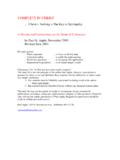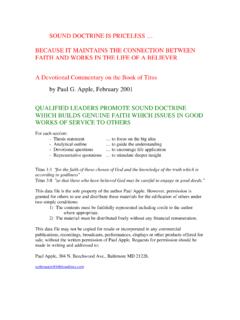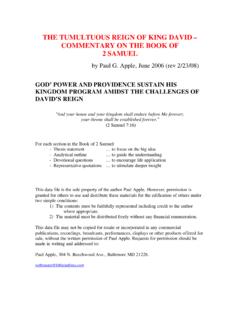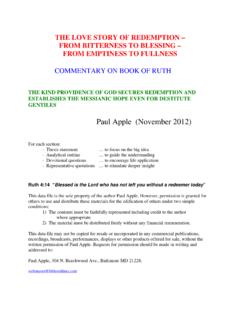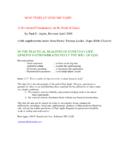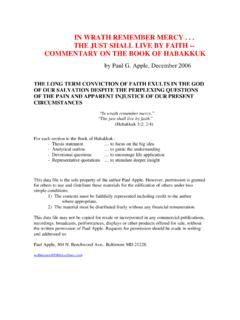Transcription of BELIEVE AND LIVE – THE GOSPEL OF JOHN
1 BELIEVE AND live THE GOSPEL OF JOHN. by Paul G. Apple, February 2004. Study of the seven special Sign Miracles Study of the I AM claims of Christ to Deity JESUS' SPECIAL SIGN MIRACLES POINT US TO FAITH. IN HIM AS THE PROMISED MESSIAH, THE SON OF GOD. WHO ALONE CAN PROVIDE SPIRITUAL LIFE. but these have been written that you may BELIEVE that Jesus is the Christ, the Son of God; and that believing you may have life in His name. (John 20:31). For each section: - Thesis statement to focus on the big idea - Analytical outline to guide the understanding - Devotional questions to encourage life application - Representative quotations to stimulate deeper insight This data file is the sole property of the author Paul Apple. However, permission is granted for others to use and distribute these materials for the edification of others under two simple conditions: 1) The contents must be faithfully represented including credit to the author where appropriate.
2 2) The materia l must be distributed freely without any financial remuneration. This data file may not be copied for resale or incorporated in any commercial publications, recordings, broadcasts, performances, displays or other products offered for sale, without the written permission of Paul Apple. Requests for permission should be made in writing and addressed to: Paul Apple, 304 N. Beechwood Ave., Baltimore MD 21228. ABOUT THE AUTHOR. Paul majored in English at Princeton University and graduated in 1979 with a Master of Divinity degree from Grace Theological Seminary in Winona Lake, IN. He lives in the Baltimore area with his wife Karen. He has worked in management roles for several local companies while engaging in pastoring and preaching responsibilities at Solid Rock Community Church.
3 His four children (and one daughter in law) enjoy a wide range of educational and professional pursuits while sharing in common a love for the Lord Jesus. BACKGROUND OF THE GOSPEL OF JOHN. The GOSPEL of John presents a very unique picture of Jesus Christ one that can lead an inquiring mind to initial faith as well as one that can deepen the faith and intimacy of the most mature believer. Even the language used partakes of this same paradoxical impact: for both the words and grammatical structure are suitable for a Beginners Greek class, while the depth of thought and complexity of meaning never cease to yield new treasures. The Synoptic gospels (Matthew, Mark and Luke) had already been penned before the disciple whom Jesus loved (21:20, 24) gathered together these important events and discourses to make the strongest case possible for driving home the claims of Christ.
4 For those who would like to disparage faith as a leap in the dark there is a preponderance of evidence presented in this GOSPEL that at times takes on a courtroom type atmosphere. For those who would claim that Jesus never claimed to be God and to be equal with God the Father it is hard to imagine that they have eve r seriously studied this document. The evidence cries out for a decision on the part of every heart. There can be no neutrality when all is said and done. It is significant that the Jews of Christ's day were either driven to receive Him as the promised Messiah or respond in anger against one whom they charged with blasphemy. There could be no middle ground back then . and there can be no middle ground today. It is just not an option to try to straddle the fence and pass Jesus off as a good man and a significant prophet.
5 In the famous words of C. S. Lewis in his classic Mere Christianity: "A man who was merely a man and said the sort of things Jesus said would not be a great moral teacher. He would either be a lunatic - on the level with a man who says he is a poached egg - or he would be the devil of hell. You must take your choice. Either this was, and is, the Son of God, or else a madman or something worse. You can shut Him up for a fool or you can fall at His feet and call Him Lord and God. But let us not come with any patronizing nonsense about His being a great human teacher. He has not left that open to us.". Liar, Lunatic or Lord there really is no other alternative. For answers to basic questions about the life of Christ or what Christianity is all about, check out: **.
6 Stedman, Ray: That is the twofold purpose of this book. First, John is setting out to give evidence why any man in any age or in any place can fully and wholeheartedly BELIEVE that Jesus is the Christ -- or to use the Hebrew form, Messiah, the Anointed One, the promised one. The second purpose is to show that he is the Son of God. A great deal is made of this term, "Son of God" today, as though there were a distinction to be made between God and the Son of God, but no Hebrew would ever understand it that way. To the Hebrews, to call someone a "son" of something was to say he is identified with, identical with, that thing or person. Barnabas was named the "Son of Consolation." That is the meaning of the name Barnabas. Why? Because he was that kind of man -- an encouraging, consoling kind of fellow.
7 His nickname meant that he was the very epitome of consolation. He was the expression of it. To the Hebrews, the use of this term, the Son of God, meant, "This one is God." That is why invariably, when our Lord used that term of himself, he was challenged by the unbelieving scribes and Pharisees, saying, "who are you? What do you make yourself out to be? Why, you make yourself to be equal with God." Of course he did. That is what the title means.. What is the meaning of Messiah? the Anointed One? "The Spirit of the Lord has come upon me," he says, ".. because he has anointed me to preach good news to the poor. {Luke 4:18b RSV}.. to proclaim release to the captives, and recovering of sight to the blind, to set at liberty those who are oppressed, to proclaim the acceptable year of the Lord.
8 " {Luke 4:18c-19 RSV). He stopped in the middle of a sentence, closed the book and sat down. Then he said to everyone there, "Today this scripture has been fulfilled in your hearing" {Luke 4:21b RSV}, that is, "I am this One.". Take those marks of the Messiah and lay them beside the seven signs that John chooses from the ministry of our Lord and you will see that he selects those particular ones because they are the signs that prove that Jesus is the Christ, the Messiah. Let me show them to you in the order in which they appear in John's GOSPEL . The first miracle of our Lord is the changing of water into wine, {John 2:1-11}. That miracle was a parable. Our Lord was performing a symbolic act at the wedding in Cana of Galilee. He took that which belonged to the realm of inanimate being, water, and changed it into a living substance, wine.}
9 He took that which belonged to the realm of death and changed it into that which is forever an expression of joy and life. By this he is declaring in symbol what he came to do: "to proclaim the acceptable year of the Lord" {Luke 4:19}. He did not come to declare the day of vengeance; he stopped before that passage in Isaiah. But he came to declare the day of grace, when God's purpose would be to take man in his brokenness, his emptiness and his lifelessness, and give to him life -- to proclaim the acceptable time of the Lord. The next sign is the healing of the nobleman's son, {John 4:46-54}. The central figure in that story is not the son, who lies sick at the door of death, but the nobleman, who comes to the Lord with a heart crushed with grief.
10 In the agony of his heart he cries out to Christ, and says, "Will you come down and heal my son?" The Lord not only heals the son at a distance, with a word, but he heals the broken heart of a father. As he said, he was anointed to heal the brokenhearted. The third sign is the healing of the impotent man who lay at the pool of Bethesda, {John 5:1-9}. Remember, that man had lain there for thirty-eight years. He had been a captive of this paralyzing disease, so that he was unable to get into the pool. He had been brought to that pool, hoping to be healed, hoping to be set free and our Lord singled him out of the great crowd of impotent folk and healed him, saying to him, "Rise, take up your pallet, and walk," {John 5:8b RSV}. Now, why? Here he was demonstrating his ability to set at liberty those who are oppressed.
